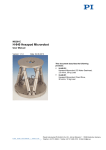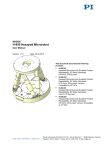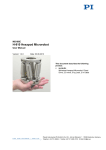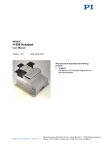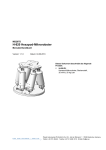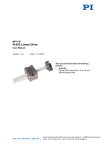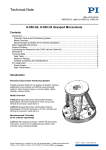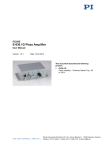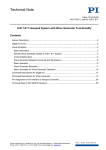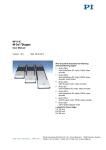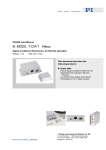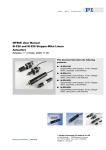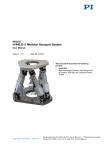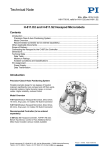Download User Manual MS207E - Physik Instrumente
Transcript
MS207E H-820 Hexapod Microrobot User Manual Version: 1.1.0 Date: 04.06.2013 This document describes the following product: H-820.D1 Hexapod Microrobot, Basic Version, 20 mm/s, 20 kg Load Physik Instrumente (PI) GmbH & Co. KG · Auf der Römerstr. 1 76228 Karlsruhe, Germany Telephon +49 721 4846-0 · Telefax +49 721 4846-1019 · E-Mail [email protected] Physik Instrumente (PI) GmbH & Co. KG is the owner of the following trademarks: PI®, PIC®, PICMA®, PILine®, PIFOC®, PiezoWalk®, NEXACT®, NEXLINE®, NanoCube®, NanoAutomation®, Picoactuator®, PInano® © 2013 Physik Instrumente (PI) GmbH & Co. KG, Karlsruhe, Germany. The text, photographs and drawings in this manual are protected by copyright. With regard thereto, Physik Instrumente (PI) GmbH & Co. KG retains all the rights. Use of said text, photographs and drawings is permitted only in part and only upon citation of the source. Original instructions First printing: 04.06.2013 Document number: MS207E, BRo, version 1.1.0 Subject to change without notice. This manual is superseded by any new release. The latest release is available for download (p. 3) on our website. Contents 1 About this Document 1.1 1.2 1.3 1.4 2 3 Goal and Target Audience of this User Manual ...................................................1 Symbols and Typographic Conventions ...............................................................1 Other Applicable Documents ................................................................................2 Downloading Manuals ..........................................................................................3 Safety 2.1 2.2 2.3 5 Intended Use ........................................................................................................5 General Safety Instructions ..................................................................................5 Organizational Measures ......................................................................................6 Product Description 3.1 3.2 3.3 3.4 3.5 3.6 1 7 Features and Applications ....................................................................................7 Model Overview ....................................................................................................8 Product View.........................................................................................................9 Scope of Delivery ...............................................................................................10 Accessories ........................................................................................................11 Technical Features .............................................................................................12 3.6.1 Struts ................................................................................................12 3.6.2 Reference Point Switch and Limit Switches .....................................12 3.6.3 Control ..............................................................................................12 3.6.4 Motion ...............................................................................................13 4 Unpacking 17 5 Installation 19 5.1 5.2 5.3 5.4 5.5 5.6 General Notes on Installation .............................................................................19 Determining the Permissible Load and Working Space .....................................20 Grounding the Hexapod .....................................................................................21 Mounting the Hexapod on a Surface ..................................................................21 Affixing the Load to the Hexapod .......................................................................23 Connecting the Cable Set to the Hexapod .........................................................25 5.6.1 Connecting the C-887.A03 Standard Cable Set ...............................25 5.6.2 Connecting the cable set with line driver boxes to the Hexapod ...........................................................................................25 6 Start-Up 6.1 6.2 7 27 General Notes on Start-Up .................................................................................27 Starting Up the Hexapod System .......................................................................28 Maintenance 7.1 7.2 7.3 29 Carrying out a Maintenance Run ........................................................................29 Packing the Hexapod for Transport ....................................................................30 Cleaning the Hexapod ........................................................................................31 8 Troubleshooting 33 9 Customer Service 35 10 Technical Data 37 10.1 10.2 10.3 10.4 Specifications......................................................................................................37 10.1.1 Data Table ........................................................................................37 10.1.2 Maximum Ratings .............................................................................38 Ambient Conditions and Classifications .............................................................38 Dimensions .........................................................................................................39 Pin Assignment ...................................................................................................42 10.4.1 Power Supply Connection ................................................................42 10.4.2 Data Transmission Connection ........................................................42 11 Old Equipment Disposal 45 12 Glossary 47 13 Appendix 51 13.1 13.2 Explanations of the Performance Test Sheet .....................................................51 EC Declaration of Conformity .............................................................................52 1 About this Document 1 About this Document In this Chapter Goal and Target Audience of this User Manual ............................................................ 1 Symbols and Typographic Conventions ........................................................................ 1 Other Applicable Documents ......................................................................................... 2 Downloading Manuals ................................................................................................... 3 1.1 Goal and Target Audience of this User Manual This manual contains information on the intended use of the H-820. It assumes that the reader has a fundamental understanding of basic servo systems as well as motion control concepts and applicable safety procedures. The latest versions of the user manuals are available for download (p. 3) on our website. 1.2 Symbols and Typographic Conventions The following symbols and typographic conventions are used in this user manual: CAUTION Dangerous situation If not avoided, the dangerous situation will result in minor injury. Actions to take to avoid the situation. NOTICE Dangerous situation If not avoided, the dangerous situation will result in damage to the equipment. Actions to take to avoid the situation. H-820 Hexapod Microrobot MS207E Version: 1.1.0 1 1 About this Document INFORMATION Information for easier handling, tricks, tips, etc. Symbol/Label Meaning 1. Action consisting of several steps whose sequential order must be observed 2. Action consisting of one or several steps whose sequential order is irrelevant List item p. 5 Cross-reference to page 5 RS-232 Labeling of an operating element on the product (example: socket of the RS-232 interface) Warning sign on the product which refers to detailed information in this manual. 1.3 Other Applicable Documents The devices and software tools which are mentioned in this documentation are described in their own manuals. 2 Description Document C-887 Hexapod controller MS204E User Manual C-887 Hexapod controller MS204Equ User Manual Short Version Version: 1.1.0 MS207E H-820 Hexapod Microrobot 1 About this Document 1.4 Downloading Manuals INFORMATION If a manual is missing on our website or if there are problems in downloading: Contact our customer service department (p. 35). The current versions of the manuals are found on our website. To download a manual, proceed as follows: 1. Open the website http://www.pi-portal.ws. 2. Click Downloads. 3. Click the corresponding category (e. g. H-Hexapods). 4. Click the corresponding product code (e. g. H-820). An overview of the available file types is shown for the selected product. 5. If (0 Files) is shown in the Documents line, log in as follows to display and download the documents: a) b) c) d) e) f) Insert the product CD in the corresponding PC drive. Open the Manuals directory. Open the Release News (e. g. C-887_Releasenews_V_x_x_x.pdf) on the CD of the product. Find the user name and password in the User login for software download section in the Release News. In the User login area on the left margin in the website, enter the user name and the password in the corresponding fields. Click Login. If Documents (0 Files) is still being displayed, no manuals are available: − Contact our customer service department (p. 35). 6. Click Documents. 7. Click the desired manual and save it on the hard disk of your PC or on a data storage medium. H-820 Hexapod Microrobot MS207E Version: 1.1.0 3 2 Safety 2 Safety In this Chapter Intended Use ................................................................................................................. 5 General Safety Instructions ........................................................................................... 5 Organizational Measures............................................................................................... 6 2.1 Intended Use The Hexapod microrobot (in short: "Hexapod") is a laboratory device in accordance with DIN EN 61010-1. It is intended to be used in interior spaces and in an environment that is free of dirt, oil and lubricants. Based on its design and realization, the Hexapod is intended for positioning, adjusting and shifting of loads in six axes at various velocities. The Hexapod is part of a Hexapod system. The intended use of the Hexapod is only possible in connection with the Hexapod controller, which is part of the Hexapod system and coordinates all motions of the Hexapod. 2.2 General Safety Instructions The H-820 is built according to state-of-the-art technology and recognized safety standards. Improper use can result in personal injury and/or damage to the H-820. Only use the H-820 for its intended purpose, and only use it if it is in a good working order. Read the user manual. Immediately eliminate any faults and malfunctions that are likely to affect safety. The operator is responsible for the correct installation and operation of the H-820. H-820 Hexapod Microrobot MS207E Version: 1.1.0 5 2 Safety 2.3 Organizational Measures User manual Always keep this user manual available by the H-820. The latest versions of the user manuals are available for download (p. 3) on our website. Add all information given by the manufacturer to the user manual, for example supplements or Technical Notes. If you pass the H-820 on to other users, also turn over this user manual as well as other relevant information provided by the manufacturer. Only use the device on the basis of the complete user manual. Missing information due to an incomplete user manual can result in minor injury and property damage. Only install and operate the H-820 after having read and understood this user manual. Personnel qualification The H-820 may only be started up, operated, maintained and cleaned by authorized and qualified staff. 6 Version: 1.1.0 MS207E H-820 Hexapod Microrobot 3 Product Description 3 Product Description In this Chapter Features and Applications ............................................................................................. 7 Model Overview ............................................................................................................. 8 Product View ................................................................................................................. 9 Scope of Delivery ........................................................................................................ 10 Accessories ................................................................................................................. 11 Technical Features ...................................................................................................... 12 3.1 Features and Applications The H-820 Hexapod achieves a velocity of up to 20 mm/s. It can be loaded with a maximum of 20 kg in a vertical orientation and with a maximum of 10 kg in any other orientation. The parallel-kinematic structure and the free choice of the pivot point offer the following advantages: Positioning operations in six independent axes (three translational axes, three rotational axes) with short settling times Pivot point is maintained for rotations and moves along with linear motions High accuracy and step resolution in all axes No addition of the errors of individual axes No friction and torques from moving cables The Hexapod is controlled with the Hexapod controller, which is part of the Hexapod system. The position commands to the Hexapod controller are entered in Cartesian coordinates. H-820 Hexapod Microrobot MS207E Version: 1.1.0 7 3 Product Description 3.2 Model Overview Hexapod and Hexapod controller are only available together as a system. Possible system components Standard versions of the H-820 Hexapod: Model Name H-820.D1 Hexapod Microrobot, Basic Version, 20 mm/s, 20 kg Load Standard versions of the C-887 Hexapod controller: Model Name C-887.11 6-D Hexapod Controller, Control of 2 Additional Servo-Motor Axes Included, TCP/IP and RS-232 Interface, 19'' Chassis C-887.21 6-D Hexapod Controller, TCP/IP and RS-232 Interface, Bench-Top Standard cable set: Model Name C-887.A03 Cable Set for Hexapod, 3 m: K040B0034 data transmission cable, MDR68 to MDR68, 1:1 K060B0111 power supply cable, M12m 180° to M12f 90° Available Hexapod systems The following Hexapod systems are available as combinations of Hexapod, Hexapod controller and cable set: System Hexapod – 8 Hexapod Controller Cable Set H-820.D1 C-887.11 C-887.21 C-887.A03 H-820.D11 x x – x H-820.D12 x – x x Version: 1.1.0 MS207E H-820 Hexapod Microrobot 3 Product Description 3.3 Product View Figure 1: Product view 1 Moving platform 2 Strut 3 Panel plug for power supply cable 4 Socket for data transmission cable 5 Base plate H-820 Hexapod Microrobot MS207E Version: 1.1.0 9 3 Product Description 3.4 Scope of Delivery The following table contains the scope of delivery of the Hexapod. The scope of delivery of the Hexapod controller is listed in the user manual of the Hexapod controller. For the scope of delivery of the cable set that belongs to the Hexapod system, see the list of the standard cable set in "Model Overview" (p. 8). Order Number Items H-820 Hexapod according to your order (p. 8) Packaging, consisting of: 2512 Inner cushion set 000012899 Inner box with handle, 560 mm x 560 mm x 400 mm 000012323 Outer box with soft foam cushions 2026 Pallet Documentation, consisting of: H820T0001 Technical note in printed form on unpacking the Hexapod MS207E User manual for the Hexapod (this document) Screw sets: 000034605 Mounting accessories: 000036450 Version: 1.1.0 1 Allen wrench 5.0 DIN 911 Accessories for connection to the grounding system: 10 6 M6x30 hex-head cap screws ISO 4762 1 M4x8 flat-head screw with cross recess ISO 7045 2 washers, form A-4.3 DIN 7090 2 safety washers, Schnorr Ø 4 mm N0110 MS207E H-820 Hexapod Microrobot 3 Product Description 3.5 Accessories Order Number Description C-887.A20 Hexapod cable set 20 m, consisting of: C-887.A30 Name Length Item ID Line driver box for data transmission cable, controllerside - C030B0011 Line driver box for data transmission cable, Hexapodside - C030B0012 Short data transmission cable MDR68 to MDR68 1:1; 2 3 m pieces K040B0034 Long data transmission cable MDR68 to MDR68 1:1 14 m K040B0186 Power supply cable for line driver box, with M12 coupling/M12 connector 17 m K060B0126 Power supply cable for Hexapod, with M12 coupling/M12 connector 20 m K060B0127 Hexapod cable set 30 m, consisting of: Name Length Item ID Line driver box for data transmission cable, controllerside - C030B0011 Line driver box for data transmission cable, Hexapodside - C030B0012 Short data transmission cable MDR68 to MDR68 1:1; 2 3 m pieces K040B0034 Long data transmission cable MDR68 to MDR68 1:1 24 m K040B0440 Power supply cable for line driver box, with M12 coupling/M12 connector 27 m K060B0160 Power supply cable for Hexapod, with M12 coupling/M12 connector 30 m K060B0161 To order, contact our customer service department (p. 35). H-820 Hexapod Microrobot MS207E Version: 1.1.0 11 3 Product Description 3.6 Technical Features 3.6.1 Struts The Hexapod has six adjustable-length struts. Each strut carries out linear motions. Each set of settings of the six struts defines a position of the moving platform in six degrees of freedom (three translational axes and three rotational axes). Each strut is equipped with the following components: One actuator Reference and limit switches Joints for connecting to the base plate and moving platform The actuator contains a direct drive, consisting of DC motor with rotary encoder and drive screw. 3.6.2 Reference Point Switch and Limit Switches The reference point switch of a strut functions independently of the angular positions of the strut ends and the lengths of the other struts. When a limit switch is activated, the power source of the motor is switched off to protect the Hexapod against damage from malfunctions. 3.6.3 Control The Hexapod is intended for operation with the Hexapod controller which belongs to the Hexapod system. The Hexapod controller makes it possible to command motion of individual axes, combinations of axes or all six axes at the same time in a single motion command. The Hexapod controller calculates the settings for the individual struts from the target positions given for the translational and rotational axes. The velocities and accelerations of the struts are calculated in such a way that all struts start and stop at the same time. After the Hexapod controller has been switched on or restarted, the Hexapod has to complete a reference move in which each strut moves to its reference point switch. After the reference move, the moving platform is in the reference position and can be commanded to move to absolute target positions. For more information, see the user manual of the Hexapod controller. 12 Version: 1.1.0 MS207E H-820 Hexapod Microrobot 3 Product Description 3.6.4 Motion The platform moves along the translational axes X, Y and Z and around the rotational axes U, V and W. Figure 2: XYZ coordinate system and rotations to the rotation coordinates U, V and W. The coordinate system is depicted above the platform for better clarity. Translation Translations are described in the spatially-fixed XYZ coordinate system. The translational axes meet at the origin of the XYZ coordinate system (0,0,0). For more information, see the glossary (p. 47). Rotation Rotations take place around the rotational axes U, V and W. The rotational axes meet at the pivot point. For more information on the pivot point, see the glossary (p. 47). In contrast to the spatially-fixed translational axes, the rotational axes and thus the pivot point as well move along with the platform (see also the example below for consecutive rotations). A given rotation in space is calculated from the individual rotations in the sequence U > V > W. H-820 Hexapod Microrobot MS207E Version: 1.1.0 13 3 Product Description INFORMATION The dimensional drawing (p. 39) contains the following: Alignment of the XYZ coordinate system Position of the pivot point after the reference move, when the standard settings of the Hexapod controller are used Example: Consecutive rotations INFORMATION For a clearer view, the figures have been adapted as follows: Round platform replaced by T-shaped platform XYZ coordinate system shown shifted Pivot point in the top left corner of the platform 1. The U axis is commanded to move to position 10. The rotation around the U axis tilts the rotational axes V and W. Figure 3: Rotation around the U axis Platform in reference position Platform position: U = 10 (U parallel to spatially-fixed X axis) 14 Version: 1.1.0 MS207E H-820 Hexapod Microrobot 3 Product Description 2. The V axis is commanded to move to position –10. The rotation takes place around rotational axis V, which was tilted during the previous rotation. The rotation around the V axis tilts the rotational axes U and W. Figure 4: Rotation around the V axis Platform in reference position Platform position: U = 10, V = –10 (U and V parallel to the platform level) H-820 Hexapod Microrobot MS207E Version: 1.1.0 15 3 Product Description 3. The W axis is commanded to move to position 10. The rotation takes place around the rotational axis W, which was tilted during the previous rotations. The W axis is always vertical to the platform level. The rotation around the W axis tilts the rotational axes U and V. Figure 5: Rotation around the W axis Platform in reference position Platform position: U = 10, V = –10, W = 10 (U and V parallel to the platform level, W vertical to the platform level) For more data on the travel ranges, see the "Specifications" section (p. 37). 16 Version: 1.1.0 MS207E H-820 Hexapod Microrobot 4 Unpacking 4 Unpacking The Hexapod is delivered in a special packaging with adapted foam inserts. NOTICE Impermissible mechanical load! An impermissible mechanical load can damage the Hexapod. Only send the Hexapod in the original packaging. Only hold the Hexapod by the base plate. Unpacking the Hexapod 1. Open the outer box. 2. Remove the foam cover. 3. Open the inner box. 4. Remove the foam cover. 5. Hold the Hexapod by the base plate and take it out of the foam insert. 6. Remove the plastic foil from the Hexapod. 7. Compare the contents against the items covered by the contract and against the packing list. If parts are incorrectly supplied or missing, contact PI immediately. 8. Inspect the Hexapod for signs of damage. If you notice signs of damage, contact PI immediately. 9. Keep all packaging materials in case the product needs to be transported again later. H-820 Hexapod Microrobot MS207E Version: 1.1.0 17 5 Installation 5 Installation In this Chapter General Notes on Installation ...................................................................................... 19 Determining the Permissible Load and Working Space .............................................. 20 Grounding the Hexapod .............................................................................................. 21 Mounting the Hexapod on a Surface ........................................................................... 21 Affixing the Load to the Hexapod ................................................................................ 23 Connecting the Cable Set to the Hexapod .................................................................. 25 5.1 General Notes on Installation The Hexapod can be mounted in any orientation. NOTICE Impermissible mechanical load and collisions! Impermissible mechanical load and collisions between the Hexapod, the load to be moved and the environment can damage the Hexapod. Only hold the Hexapod by the base plate. Before installing the load, determine the limit value for the load of the Hexapod with a simulation program (p. 20). The limit values determined with the simulation program are only valid when the Hexapod controller has the servo mode switched on for the axes of the moving platform of the connected Hexapod. Before installing the load, determine the working space of the Hexapod with a simulation program (p. 20). The limits of the working space vary depending on the current position of the Hexapod (translation and rotation coordinates) and the current coordinates of the pivot point. Avoid high forces and torques on the moving platform during installation. Ensure an uninterruptible power supply in order to prevent an unintentional deactivation of the Hexapod system and resulting unintentional position changes of the Hexapod. Make sure that no collisions between the Hexapod, the load to be moved and the environment are possible in the working space of the Hexapod. H-820 Hexapod Microrobot MS207E Version: 1.1.0 19 5 Installation INFORMATION The optionally available PIVeriMove software for collision checking can be used to mathematically check possible collisions between the Hexapod, the load and the environment. The use of the software is recommended when the Hexapod is located in a limited installation space and/or operated with a spatially limiting load. For details regarding the activation and configuration of the PIVeriMove software for collision checking, see Technical Note C887T0002 (included in the scope of delivery of the software). 5.2 Determining the Permissible Load and Working Space Tools and accessories PC with Windows operating system on which the simulation program Hexapod Simulation Software is installed. For more information, see the manual of the Hexapod controller. Determining the working space and permissible load of the Hexapod Follow the instructions in the manual of the Hexapod controller to determine the working space and the limit value for the load of the Hexapod with the simulation program. The limit values in the following table are for orientation. They only apply when the center of mass is at the origin of the XYZ coordinate system (0,0,0). Servo mode switched on for Hexapod – Servo mode switched off for Hexapod – max. load capacity max. holding force Mounting position of the base plate Mounted horizontally Mounted as desired Mounted horizontally Mounted as desired H-820.D1 20 kg 10 kg 200 N 100 N If you need help in determining the limit value for the load or determining the work space: Contact our customer service department (p. 35). 20 Version: 1.1.0 MS207E H-820 Hexapod Microrobot 5 Installation 5.3 Grounding the Hexapod The Hexapod is not grounded via the power supply cable. If a functional grounding is required for potential equalization: 1. Connect the base plate to the grounding system: − For connection, use the supplied accessories (p. 10) and the M4 hole marked with the ground connection symbol (p. 39). 2. Connect the moving platform to the grounding system: − Use one of the mounting holes in the moving platform (p. 39) for connection. or − If the moving platform and the load are conductively connected with each other, connect the load to the grounding system. 5.4 Mounting the Hexapod on a Surface NOTICE Impermissible mechanical load! An impermissible mechanical load can damage the Hexapod. Only hold the Hexapod by the base plate. NOTICE Warping of the base plate! Incorrect mounting can warp the base plate. Warping of the base plate reduces the accuracy. Mount the Hexapod on an even surface. The recommended evenness of the surface is 300 µm. H-820 Hexapod Microrobot MS207E Version: 1.1.0 21 5 Installation Figure 6: Mounting holes in the base plate Prerequisite You have read and understood the General Notes on Installation (p. 19). Tools and accessories Allen wrench 5.0 and three of the supplied screws (p. 10). Mounting the Hexapod 1. Provide three M6 threaded holes in the support for mounting with M6x30 screws. The arrangement of the mounting holes in the base plate of the Hexapod can be found in the dimensional drawing (p. 39) as well as in the corresponding figure. 2. Mount the Hexapod on the three mounting holes in the base plate using the included M6x30 screws. 22 Version: 1.1.0 MS207E H-820 Hexapod Microrobot 5 Installation 5.5 Affixing the Load to the Hexapod NOTICE Impermissible mechanical load and collisions! Impermissible mechanical load and collisions between the Hexapod, the load to be moved, and the environment can damage the Hexapod. Make sure that the installed load observes the limit value resulting from the load test (p. 20). Avoid high forces and torques on the moving platform during installation. Make sure that no collisions between the Hexapod, the load to be moved and the environment are possible in the work space of the Hexapod. NOTICE Screws that are too long! The Hexapod can be damaged by excessively long screws. When selecting the screw length, observe the thickness of the moving platform or the depth of the mounting holes (p. 39) together with the load to be mounted. Only use screws that do not project under the moving platform after being screwed in. Only mount the Hexapod and the load on the mounting fixtures (holes) intended for this purpose. H-820 Hexapod Microrobot MS207E Version: 1.1.0 23 5 Installation Figure 7: M6 mounting holes in the moving platform Prerequisites You have read and understood the General Notes on Installation (p. 19). You have determined the permissible load and the work space of the Hexapod (p. 20). You have designed the load and the environment of the Hexapod so that the permissible load of the Hexapod is observed and no collisions can occur. Tools and accessories At least three M6 screws with suitable length Suitable tools for fastening the screws Affixing the Load 1. Align the load so that at least three mounting holes in the moving platform can be used for affixing the load. The arrangement of the mounting holes in the moving platform of the Hexapod can be found in the dimensional drawing (p. 39) as well as in the corresponding figure. 2. Affix the load to the selected mounting holes in the moving platform using the screws. 24 Version: 1.1.0 MS207E H-820 Hexapod Microrobot 5 Installation 5.6 Connecting the Cable Set to the Hexapod 5.6.1 Connecting the C-887.A03 Standard Cable Set Prerequisites The cable set is not connected to the Hexapod controller. Tools and accessories Cable set C-887.A03 that belongs to the Hexapod system (p. 8) Connecting the C-887.A03 standard cable set to the Hexapod 1. Connect the data transmission cable to the MDR68 socket in the base plate of the Hexapod: a) b) c) d) Press the latches together on both sides of the connector. Insert the connector into the socket on the Hexapod. Check that the connector correctly fits. Release the latches. 2. Connect the 90° angled M12 coupling of the power supply cable to the 4-pin M12 panel plug in the base plate of the Hexapod. − Observe the mechanical coding of the coupling and panel plug. − Do not use force. 5.6.2 Connecting the cable set with line driver boxes to the Hexapod Prerequisites The cable set is not connected to the Hexapod controller. Tools and accessories Long cable set with two line driver boxes; available as optional accessories (p. 11). Connecting the cable set with line driver boxes to the Hexapod Connect the Hexapod and cable set with each other as shown in the connection diagram below. − Observe the assignment that is given by the labeling on the sockets, connectors and cables. − When handling the connectors, proceed as described in "Connecting the C-887.A03 Standard Cable Set" (p. 25). H-820 Hexapod Microrobot MS207E Version: 1.1.0 25 5 Installation Do not connect the cable set to the Hexapod controller yet. Figure 8: Connection diagram of cable set with line driver boxes 1 Line driver box for data transmission cable, controller-side 2 Line driver box for data transmission cable, Hexapod-side 3 Short data transmission cable MDR68 to MDR68 1:1 (3 m) 4 Long data transmission cable MDR68 to MDR68 1:1 5 Power supply cable for line driver box, with M12 coupling/M12 connector 6 Power supply cable for Hexapod, with M12 coupling/M12 connector For the length of the cables 4, 5 and 6 and the item IDs of the components, see "Optional Accessories" (p. 11). 26 Version: 1.1.0 MS207E H-820 Hexapod Microrobot 6 Start-Up 6 Start-Up In this Chapter General Notes on Start-Up .......................................................................................... 27 Starting Up the Hexapod System ................................................................................ 28 6.1 General Notes on Start-Up CAUTION Risk of crushing by moving parts! There is a risk of minor injuries caused by crushing which can occur between the moving parts of the Hexapod and a stationary part or obstacle. Keep your fingers away from areas where they can get caught by moving parts. NOTICE Incorrect configuration of the Hexapod controller! The configuration data used by the Hexapod controller (e. g. geometrical data and servo-control parameters) must be adapted to the Hexapod. If incorrect configuration data is used, the Hexapod can be damaged by uncontrolled motions or collisions. The configuration data is adapted before delivery. Check whether the Hexapod controller matches the Hexapod. A label on the rear panel of the controller indicates for which Hexapod the controller is intended. When you have established the communication via TCP/IP or RS-232 or use the user interface of the C-887, send the CST? command. The response shows the Hexapod to which the controller is adapted. Only operate the Hexapod with a Hexapod controller whose configuration data is adapted to the Hexapod. H-820 Hexapod Microrobot MS207E Version: 1.1.0 27 6 Start-Up NOTICE Damage from collisions! Collisions can damage the Hexapod, the load to be moved, and the environment. Make sure that no collisions between the Hexapod, the load to be moved and the environment are possible in the work space of the Hexapod. Do not place any objects in areas where they can get caught by moving parts. If the Hexapod controller malfunctions, stop the motion immediately. 6.2 Starting Up the Hexapod System Prerequisite You have read and understood the General Notes on Start-Up (p. 27). You have correctly installed the Hexapod, i.e. you have mounted the Hexapod on a surface and affixed the load to the Hexapod according to the instructions in "Installation" (p. 19). You have read and understood the user manual of the Hexapod controller. Accessories Hexapod controller belonging to the Hexapod system PC with suitable software (see user manual of the Hexapod controller) Starting up the Hexapod system 1. Connect the Hexapod to the Hexapod controller (see user manual of the Hexapod controller). 2. Start up the Hexapod controller (see user manual of the Hexapod controller). 3. Operate a few motion cycles for testing purposes (see user manual of the Hexapod controller). 28 Version: 1.1.0 MS207E H-820 Hexapod Microrobot 7 Maintenance 7 Maintenance In this Chapter Carrying out a Maintenance Run ................................................................................. 29 Packing the Hexapod for Transport ............................................................................. 30 Cleaning the Hexapod ................................................................................................. 31 NOTICE Damage due to improper maintenance! The Hexapod can become misaligned as a result of improper maintenance. The specifications can change as a result (p. 37). Only loosen screws according to the instructions in this manual. Depending on the operational conditions and the period of use of the Hexapod, the following maintenance measures are required. 7.1 Carrying out a Maintenance Run Frequent motions over a limited travel range can cause the lubricant to be unevenly distributed on the drive screw. Carry out a maintenance run over the entire travel range at regular intervals (see user manual of the Hexapod controller). The more often motions are carried out over a limited travel range, the shorter the time between the maintenance runs has to be. H-820 Hexapod Microrobot MS207E Version: 1.1.0 29 7 Maintenance 7.2 Packing the Hexapod for Transport NOTICE Impermissible mechanical load! An impermissible mechanical load can damage the Hexapod. Only send the Hexapod in the original packaging. Only hold the Hexapod by the base plate. NOTICE Damage from applying high forces! Hexapod struts with direct drive can be carefully moved by hand in the case of an error. Blocked struts can be damaged by the use of force. If one or more struts of the Hexapod are blocked, do not move the Hexapod by hand. If you move the Hexapod by hand, do not use high forces. Accessories Original packaging (p. 10) Packing the Hexapod 1. Command a motion of the Hexapod to the transport position: X=Y=Z=U=V=W =0 2. Uninstall the Hexapod system: a) b) c) d) e) Remove the load from the moving platform of the Hexapod. Power down the Hexapod controller. Remove the data transmission cable and the power supply cable from the Hexapod controller and the Hexapod. Loosen the three M6x30 screws with which the Hexapod is mounted on the surface. Remove the three M6x30 screws. 3. Wrap the Hexapod in a plastic foil to protect it against dirt. 4. Open the outer box. 30 Version: 1.1.0 MS207E H-820 Hexapod Microrobot 7 Maintenance 5. Remove the foam cover. 6. Open the inner box. 7. Remove the foam cover. 8. Hold the Hexapod by the base plate and place it in the foam insert of the inner box. 9. Insert the foam cover in the inner box. 10. Close the inner box. 11. Insert the foam cover in the outer box. 12. Close the outer box. 13. Secure the box on the pallet. 7.3 Cleaning the Hexapod Prerequisites You have disconnected the Hexapod from the controller. Cleaning the Hexapod When necessary, clean the Hexapod surface with a towel lightly dampened with a mild cleanser or disinfectant. Do not use any organic solvents. H-820 Hexapod Microrobot MS207E Version: 1.1.0 31 8 Troubleshooting 8 Troubleshooting Problem Possible Causes Solution Unexpected Hexapod behaviour. Cable broken Connector or soldered joints loosened Check the data transmission and power supply cables. Replace the cables by cables of the same type and test the function of the Hexapod. Contact our customer service department (p. 35). Mount the Hexapod on an even surface (p. 21). The recommended evenness of the surface is 300 µm. The Hexapod does Warped base plate not achieve the specified accuracy. The Hexapod does not move. Increased wear due to small motions over a long period of time Carry out a maintenance run over the entire travel range (p. 29). Worn drive screw Faulty motor Dirty encoder Carry out a strut test (see user manual of the Hexapod controller). The strut test should be carried out in the reference position, unless the malfunction occurs with maximum or minimum displacement of the platform in Z. Contact our customer service department (p. 35). Foreign body has entered the drive screw Blocked or broken joint If the problem with your Hexapod is not listed in the table or cannot be solved as described, contact our customer service department (p. 35). H-820 Hexapod Microrobot MS207E Version: 1.1.0 33 9 Customer Service 9 Customer Service For inquiries and orders, contact your PI sales engineer or send us an e-mail (mailto:[email protected]). If you have questions concerning your system, have the following information ready: Product codes and serial numbers of all products in the system Firmware version of the controller (if present) Version of the driver or the software (if present) Operating system on the PC (if present) The latest versions of the user manuals are available for downloading (p. 3) on our website. H-820 Hexapod Microrobot MS207E Version: 1.1.0 35 10 Technical Data 10 Technical Data In this Chapter Specifications .............................................................................................................. 37 Ambient Conditions and Classifications ...................................................................... 38 Dimensions .................................................................................................................. 39 Pin Assignment ............................................................................................................ 42 10.1 Specifications 10.1.1 Data Table H-820.D12 Active axes Unit Tolerance X, Y, Z, θX, θY, θZ Motion and positioning Travel range* X, Y ±50 mm Travel range* Z ±25 mm Travel range* θX, θY ±15 ° Travel range* θZ ±30 ° Actuator drive Torque motor, brushless (BLDC) Single-actuator design resolution 0.2 µm typ. Min. incremental motion X, Y, Z 20 µm typ. Min. incremental motion θX, θY, θZ 50 µrad typ. Repeatability X, Y, Z ±20 µm typ. Repeatability θX, θY, θZ ±200 µrad Backlash X, Y, Z 50 µm Max. velocity X, Y, Z 20 mm/s Max. velocity θX, θY, θZ 200 mrad/s Load (baseplate horizontal) 20 kg max. Load (base plate in any orientation) 10 kg max. Holding force (baseplate horizontal) 200 N max. Holding-force (baseplate in any orientation) 100 N max. Mechanical properties H-820 Hexapod Microrobot MS207E Version: 1.1.0 37 10 Technical Data Miscellaneous Operating temperature range 0 to +50 °C Material Aluminum Mass 15 kg ±5% Cable length 3 m ±10 mm Controller included in delivery Operating voltage 100-240 VAC, 50/60 Hz Order as a system including controller and software. Add number 1 or 2 to the order number: H820.xx1 for C-887.11; H-820.xx2 for C-887.21. Technical data specified at 20±3°C. Ask about custom designs! * The travel ranges of the individual coordinates (X, Y, Z, θX, θY, θZ) are interdependent. The data for each axis in this table shows its maximum travel, where all other axes are at their zero positions. If the other linear or rotational coordinates are not zero, the available travel may be less. 10.1.2 Maximum Ratings The Hexapod is designed for the following operating data: Maximum operating voltage Maximum operating frequency (unloaded) Maximum current consumption 24 V DC 5A 10.2 Ambient Conditions and Classifications Degree of pollution: 2 Transport temperature: –25°C to +85°C Storage temperature: 0 °C to 70 °C Humidity: Maximum relative humidity of 80% at temperatures of up to 31°C, linearly decreasing until relative humidity of 50% at 40°C Degree of protection according to IP20 IEC 60529: 38 Area of application: For indoor use only Maximum altitude: 2000 m Version: 1.1.0 MS207E H-820 Hexapod Microrobot 10 Technical Data 10.3 Dimensions All figures show the Hexapod in the reference position. Dimensions in mm. Note that the decimal places are separated by a comma in the drawings. Figure 9: H-820 Hexapod, view from left (dimensions in mm) The (0,0,0) coordinates refer to the origin of the XYZ coordinate system. When the default settings of the Hexapod controller are used and the Hexapod is in the reference position, the pivot point is located at the origin of the XYZ coordinate system. H-820 Hexapod Microrobot MS207E Version: 1.1.0 39 10 Technical Data Figure 10: H-820 Hexapod, base plate, sectional view A-A (dimensions in mm) This sectional view shows details of the base plate of the Hexapod: 40 Position of M4 hole for ground connection Connections for power supply and data transmission Version: 1.1.0 MS207E H-820 Hexapod Microrobot 10 Technical Data Figure 11: H-820 Hexapod, view from front (dimensions in mm) H-820 Hexapod Microrobot MS207E Version: 1.1.0 41 10 Technical Data 10.4 Pin Assignment 10.4.1 Power Supply Connection Power supply via 4-pin, A-coded M12 panel plug Pin Function 1 GND 2 GND 3 24 V DC 4 24 V DC 10.4.2 Data Transmission Connection Data transmission between the Hexapod and the Hexapod controller MDR68 socket Function Socket All signals: TTL 42 Version: 1.1.0 MS207E H-820 Hexapod Microrobot 10 Technical Data Pin assignment H-820 Hexapod Microrobot MS207E Version: 1.1.0 43 11 Old Equipment Disposal 11 Old Equipment Disposal In accordance with the applicable EU law, electrical and electronic equipment may not be disposed of with unsorted municipal wastes in the member states of the EU. When disposing of your old equipment, observe the international, national and local rules and regulations. To meet the manufacturer’s product responsibility with regard to this product, Physik Instrumente (PI) GmbH & Co. KG ensures environmentally correct disposal of old PI equipment that was first put into circulation after 13 August 2005, free of charge. If you have old PI equipment, you can send it postage-free to the following address: Physik Instrumente (PI) GmbH & Co. KG Auf der Römerstr. 1 D-76228 Karlsruhe, Germany H-820 Hexapod Microrobot MS207E Version: 1.1.0 45 12 Glossary 12 Glossary Work space The entirety of all combinations of translations and rotations that the Hexapod can approach from the current position is referred to as the work space. The work space can be limited by the following external factors: Installation space Dimensions and position of the load Pivot point The pivot point describes the center of rotation (intersection of the rotational axes U, V and W). When the standard settings for the pivot point coordinates are used, the pivot point is located at the origin of the XYZ coordinate system after a reference move, see the dimensional drawing (p. 39) for more information. The pivot point is shifted along with the platform during translations. Rotations do not change the position of the pivot point. The pivot point coordinates remain unchanged in both cases. The pivot point coordinates can be changed in the Hexapod controller. XYZ coordinate system The position and orientation of the Cartesian XYZ coordinate system cannot be changed, which is why the system is referred to as spatially fixed. The axes X, Y and Z are referred to as translational axes. The intersection of the axes of the spatially-fixed Cartesian XYZ coordinate system (0,0,0) is referred to as the origin. The Z axis is always perpendicular to the base plate of the Hexapod. H-820 Hexapod Microrobot MS207E Version: 1.1.0 47 12 Glossary The following example figures of the H-810 Hexapod show that the XYZ coordinate system does not move along with motions of the platform. Figure 12: H-810 Hexapod in the reference position. 1 48 Cable outlet Version: 1.1.0 MS207E H-820 Hexapod Microrobot 12 Glossary Figure 13: H-810 Hexapod, the platform of which has been moved in X. 1 H-820 Hexapod Microrobot Cable outlet MS207E Version: 1.1.0 49 13 Appendix 13 Appendix In this Chapter Explanations of the Performance Test Sheet .............................................................. 51 EC Declaration of Conformity ...................................................................................... 52 13.1 Explanations of the Performance Test Sheet The Hexapod is tested for the positioning accuracy of the translational axes before delivery. The performance test sheet is included in the scope of delivery. The following figure shows the test setup used. Figure 14: Test setup for measuring the X or Y axis. 1 Laser interferometer 2 Mirror 3 Bench The following test cycles are performed: Movement over the entire travel range with at least 20 measuring points, in at least five cycles. Movement over partial sections, e. g. ±1 mm in increments of e. g. 10 µm H-820 Hexapod Microrobot MS207E Version: 1.1.0 51 13 Appendix 13.2 EC Declaration of Conformity 52 Version: 1.1.0 MS207E H-820 Hexapod Microrobot
























































